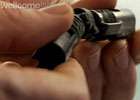Robotics award for i-Snake team (w/ video)

The research team behind a robotic snake-like device for surgery called i-Snake have won a prestigious award at the IEEE International Conference on Robotics and Automation.
The team from the Hamlyn Centre at Imperial College London are developing the device with support from a Wellcome Trust Strategic Translation Award. They took home the Best Medical Robotics Paper Award at this year's annual gathering of the robotics community.
The paper, entitled 'An articulated universal joint based flexible access robot for minimally invasive surgery', introduced the key design features of the joint mechanism used by i-Snake. It incorporates a unique hybrid tendon-micromotor arrangement that enables fully controllable articulation of the robot while maintaining large inner channels for imaging probes and surgical instruments.
Dr Jian-Zhong Shang, who presented the paper at the conference, described the detailed mechatronic design of the system, as well as results from animal experiments using the robot to perform surgical sterilisation procedures.
The IEEE International Conference on Robotics and Automation (ICRA) Best Medical Robotics Paper Award is sponsored by Intuitive Surgical to recognise outstanding work in the area of medical robotics and computer-assisted interventional devices and systems, with specific emphases on technological innovation and clinical efficacy.
Congratulating the team on the award, Professor Guang-Zhong Yang, Director of the Hamlyn Centre, said: "This is a great recognition to our multidisciplinary team who have been working hard to bring a bold engineering concept to reality. There are still significant hurdles ahead of us in translating our research results into routine clinical practice, but I am confident that this will happen in the near future."
The main focus of the Wellcome Trust-supported i-Snake® research programme is developing a fully articulated snake robot that integrates imaging and sensing to address key limitations of the current rigid instrument and laparoscope design of minimally invasive surgery. A range of challenging research issues are being addressed by the Hamlyn team, including joint articulation, integrated sensing, navigation and control, imaging inside live subjects, tissue characterisation, motion tracking, and surgical navigation under active constraints.
By integrating imaging and sensing, the i-Snake® robot will potentially enable an expansion of applications for robotic-assisted minimally invasive surgery, for performing gastrointestinal, gynaecological and, eventually, cardiothoracic surgery.The i-Snake® robot is expected to make significant advances in robotic surgery and ensure greater success in the development of future clinical robotic systems.
Provided by Wellcome Trust

















